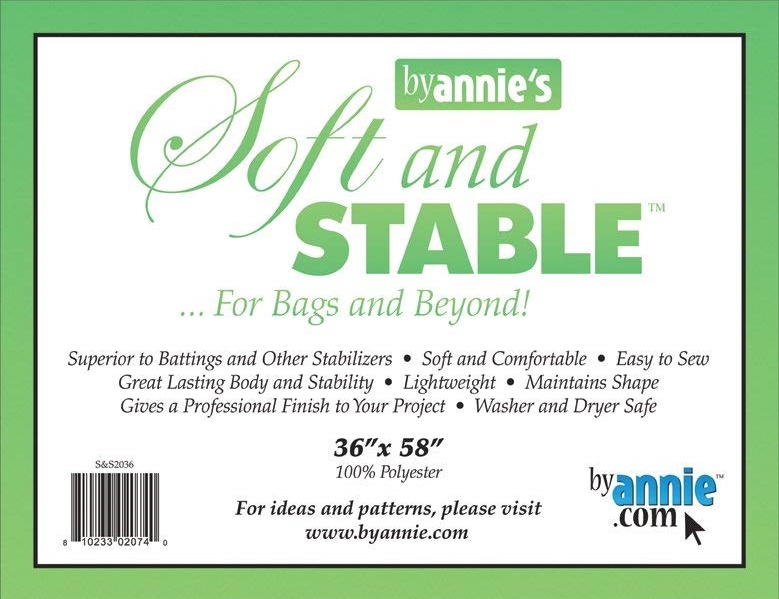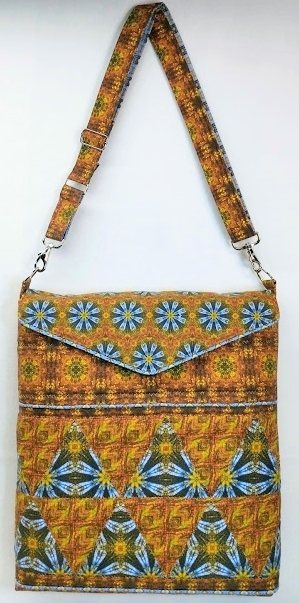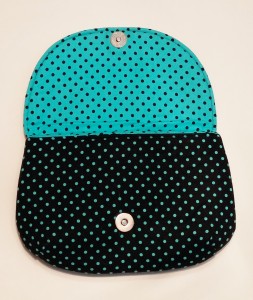
One of the really great things about sewing is that you aren’t dependent on what you can find (or afford) in the store – you can create or customize all kinds of things to your specific tastes and needs.
Lately, I’ve been on a streak of making totes, bags and purses.
Since my work (both as Creative Director for Lakeshore Sewing and as a quilt/textile artist and designer for my own business) requires a lot of intense focus and creativity, I find it relaxing to take a bit of a break and let someone else do the basic designing and let me have the fun of customizing to my heart’s content.
I really enjoy it when I get a chance to make something quick and (relatively) easy. And bonus points if it is functional, too!
One of the products I’ve been playing with lately is Soft and Stable from ByAnnie.
Product info from the ByAnnie.com website:
BYANNIE’S SOFT AND STABLE® OVERVIEW
ByAnnie’s Soft and Stable® is a new product which I developed to use in place of batting or other stabilizers in purses, bags, totes, home dec items, and more.
Why use ByAnnie’s Soft and Stable®?
- Great lasting body and stability
- Lightweight
- Maintains shape
- Gives a professional finish to your project
- Easy to sew
- Fabric can be quilted to ByAnnie’s Soft and Stable® or just sewn around the edges of the pieces — no need to quilt every 2 to 4″ as with batting
- Soft and comfortable
- Washer and dryer safe
My summary – I love it! But…
I am very happy with the shape, structure, and finish of bags I’ve made with Soft and Stable. They look great, hold their shape, and don’t collapse under the weight of the straps or handles – all while remaining lightweight and easy to carry. The extra protection for the contents is pretty great, too – especially for things like a phone, tablet, laptop, sewing machine, etc. I’ve given the sewing machine travel bag I made with Soft and Stable away as a gift, but here is another great example of a well-used bag still holding its shape after a couple of years and a lot of use:

But I don’t always find it as straightforward to use as is sometimes implied…
Unlike Pellon Fusible Flex Foam or Bosal In-R-Form 2 Sided Fusible Foam Stabilizer, Soft and Stable isn’t fusible. This was a deliberate choice, as explained in the educational videos on the ByAnnie.com website, as it prevents that “cellulite” look you sometimes see in bags interfaced with fusible batting, fleece, or interfacing/stabilizer.
Despite the fact that it isn’t fused, a strong selling point on the website is that you don’t need to quilt it to your bag fabric in order to keep it from shifting (as you would if you used non-fusible batting, fleece or interfacing/stabilizer). Instead, you lay your fabric pattern piece on top of the Soft and Stable and stitch around the perimeter, making sure to stay within the seam allowance so that this stitching will not be visible in the finished bag. (Soft and Stable has a fabric-finish on both sides, so you don’t have worry about foam crumbling into your sewing machine when you sew.)
I find this works just great when I am working with bag or tote patterns with simple shapes that don’t have too many seams coming together in one area.

However, when I am working on a more complicated bag, a bag with multiple layers, or a bag with piping around the edges, I find that the extra bulk of the foam in the seam allowances can be very cumbersome and sometimes very difficult to sew through. I broke 3 needles while making my messenger bag!

My normal preference when using thick interfacings such as foam is to (whenever practical) cut the interfacing without seam allowances – allowing me to sew right next to the interfacing, but not through it, when assembling my bag. This makes assembly much easier! However, it does require me to anchor the interfacing to the bag fabric in some way, usually by quilting at least a few lines, if not all-over.
NOTE: you can easily quilt through Soft and Stable; just remember to use your walking foot or free-motion foot.
What worked best for me:
Note: Similar options – and more! – are demonstrated in the instructional video series on the ByAnnie website. I highly recommend watching these videos.
- For simple bags – prep the pieces as recommended first on the website by stitching the fabric to the Soft and Stable inside the seam allowances and proceed as usual.
- For more complex bags – prep the pieces as recommended first on the website by stitching the fabric to the Soft and Stable inside the seam allowances, and then trim away most of the Soft and Stable in the seam allowances after sewing. It’s a tedious job (and thankfully not necessary on simple shapes!), but extremely helpful when working with lots of layers or multiple seams coming together in a relatively small area. OR
- Cut the Soft and Stable without seam allowances, and quilt it to the fabric (or at least anchor it with a few lines of stitching), keeping the Soft and Stable out of the seams entirely.
- When it comes to flaps for bags which I’ve interfaced with Soft and Stable, I go ahead and use Soft and Stable for the flap as well if the shape is simple; but sometimes switch to something like Pellon 987F Fusible Fleece, Thermolam or Fusible Thermolam Plus for the flap if I’m already working with layers that are so thick they are getting difficult to sew through.

When it comes to flaps for bags which I’ve interfaced with Soft and Stable, I go ahead and use Soft and Stable for the flap as well if the shape is simple, such as this Glenda Clutch from BAGS – THE MODERN CLASSICS by Sue Kim 
Glenda Clutch from BAGS – THE MODERN CLASSICS by Sue Kim, made by Beth Ann Williams 
But I sometimes switch to something like Pellon 987F Fusible Fleece, Thermolam or Fusible Thermolam Plus for the flap if I’m already working with layers so thick that they are getting hard to sew through – in this case, layers of pieced fabric, piping, and straps, as well as the thickness of the foam. Messenger Bag made with fabric from the Changing Seasons collection by Beth Ann Williams. Based on Kantha Tote Bag pattern by PennyDog Patterns. - Clover Wonder Clips (or these generic versions) are MUCH easier to use than pins when working with thick or lofty battings, and interfacings/stabilizers such as Soft and Stable.
- Switching to a size 80 Jeans or Topstitch needle or a size 90 Quilting Needle instead of the size 75 I would normally use, helped avoid/correct skipped stitches and/or needle breakage.
- Lengthening the stitch slightly when topstitching can also be helpful. 🙂
In conclusion
Will I continue buying Soft and Stable? Absolutely!
It seems a little bit loftier and softer than Bosal In R Form Double Sided Fusible Foam Stabilizer and a little softer but also a little bit less lofty than the Pellon Flex Foam 2 Sided Fusible Stabilizer , so which interfacing/stabilizer I choose will depend on the project I am working on – and to be quite honest, on what I happen to have on hand that day, since they are pretty comparable.
I apologize for not seeing your question sooner – its about 3/16″ thick. Best wishes always, Beth Ann